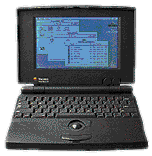Portable computers have been around for over 20 years, allowing
users to do their work almost anywhere. Some of the early portable
computers, such as the pioneering
Osborne 1, were very heavy and had to be plugged into an AC
outlet to function.
Later on, companies starting adding batteries to portable
computers, giving users the ability to use their computers in
places where there is no power. Some of the early portable
computers were the
KayPro,
Compaq Portable, and Apple
//c.
Eventually, the idea came about to put this technology into a
smaller package and run it with batteries. The Radio Shack
TRS-80 Model 100 is often considered the first
"laptop" computer.
Later on, the design changed and laptops came with a screen
doubling as a lid, closing over the keyboard below it. Among these
were the
Toshiba T1000, sometimes called the first real laptop.
Soon other companies found ways to make the package smaller and
more portable. Among these smaller computers were the
Compaq LTE 286 and the Apple
PowerBook 100.
Compared to the others, the PowerBook 100 was lighter, had a
better battery, and even included a built in  pointing device. It also had a faster and more
efficient processor than many of the 286 and 386 PC compatibles
(some ran as slowly as 8 MHz). The PB 100 was also reasonably
priced compared to some of the PC portables that were
available.
pointing device. It also had a faster and more
efficient processor than many of the 286 and 386 PC compatibles
(some ran as slowly as 8 MHz). The PB 100 was also reasonably
priced compared to some of the PC portables that were
available.
The standard design had become something like the laptops of
today, but there were a couple companies out there that tried to
make a better laptop computer. Among them was the Outbound Laptop, one of the first
Mac clones. It was encased in a box similar to that of other
portable computers.
Powered by a standard video camera battery, the Outbound
featured a 12 MHz Motorola 68HC000 processor, 1 to 4 MB of
RAM, and either an internal 20 MB hard drive or an internal 1.44 MB
floppy, as well as an optional RAM disk as large as 16 MB. The
Outbound came with a detachable IR keyboard and pointing device, as
well as the ability to connect to a Mac
SE or Plus and use both
monitors and the processors in both machines to become twice as
fast as when run alone. The keyboard and pointing device came down
in one piece from in front of the screen, and a stand would fold
out from the back so that the screen could be tilted at an
angle.
After developing a style, companies had to do several things.
First, they needed to come up with some features to make these
portable computers compelling to those who depended on some of the
functionality of a desktop computer. Among the first of these was a
color screen. Dell's 386 models offered a color display, as did
IBM's ThinkPad 360 series and Apple's PowerBook 165c and 180c.
But color wasn't enough. People wanted to be able to communicate
with their desktop computer and send faxes as well. Apple had an
optional fax modem in the PowerBook 100 series, and Compaq had that
option in its 386 and 486 portables.
What had to come next was a name. Some companies had these
already, such as IBM with its ThinkPad name and Apple with
PowerBook (in my opinion, these are the two best names out there).
Other companies, such Gateway, Compaq, and Dell, were still using
"386" and "486" in the model name. Gateway chose to adopt "Solo,"
Compaq chose "Armada" for some of its machines, and Dell chose
"Latitude" for its high-end portables.
Now that these portables had catchy names and a decent set of
features, all that remained was price.
Laptops were always very expensive, and remained expensive until
Apple introduced the PowerBook 150,
which  in 1995 was very affordable at $1,450,
although it lacked features that some users demanded.
in 1995 was very affordable at $1,450,
although it lacked features that some users demanded.
In 1999, Apple again introduced a reasonably priced laptop. The
iBook, at $1,599, was inexpensive
and designed just for those looking to start out with a portable
computer or those going to school not wanting to risk damaging a
more expensive model.
In 2001, Apple topped this with the
iBook (dual USB) for $,1299. Coming with twice the RAM and
three times the hard disk space of the original iBook, the new
iBook looked like it could hardly be beat in price.
However, IBM managed to do just that. Its ThinkPad R30 series,
starting at $929, comes with a 13.3" screen, a 900 MHz Celeron
processor, a 10 GB hard drive, and 128 MB of RAM. Of course, like
the base model iBook, it is meant for those on a budget, but both
it and the Apple iBook prove that portable computing technology is
now inexpensive enough for schools, students, and home users.

 pointing device. It also had a faster and more
efficient processor than many of the 286 and 386 PC compatibles
(some ran as slowly as 8 MHz). The PB 100 was also reasonably
priced compared to some of the PC portables that were
available.
pointing device. It also had a faster and more
efficient processor than many of the 286 and 386 PC compatibles
(some ran as slowly as 8 MHz). The PB 100 was also reasonably
priced compared to some of the PC portables that were
available. in 1995 was very affordable at $1,450,
although it lacked features that some users demanded.
in 1995 was very affordable at $1,450,
although it lacked features that some users demanded.
